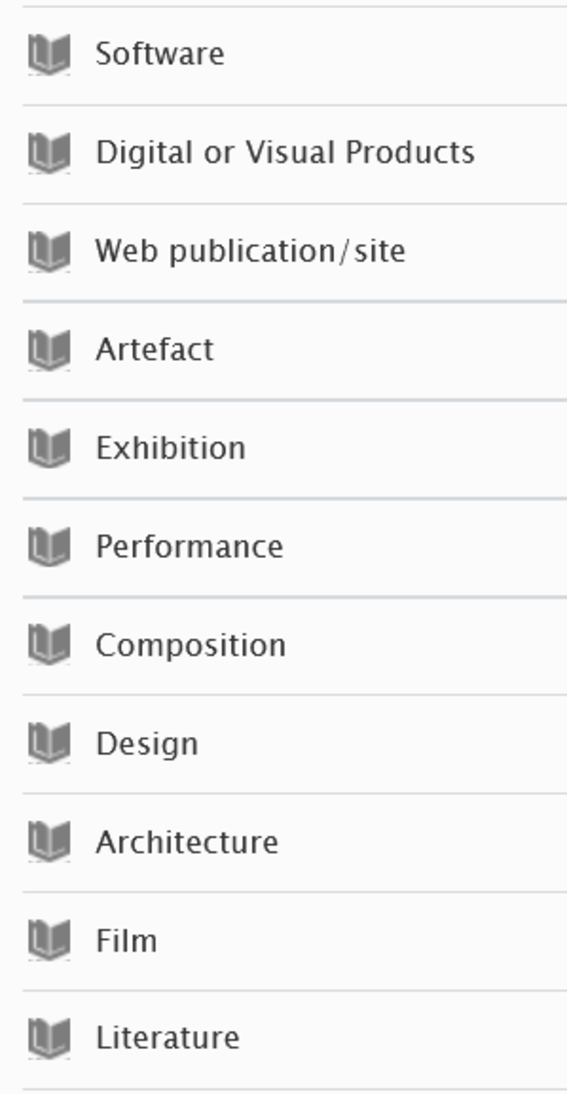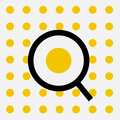Adding artistic and non-textual outputs to ACRIS
Introduction
Artistic outputs are equivalent to research outputs in ACRIS. The eligibility criteria below follow the guidelines of the Ministry of Education and Culture in Finland.
- The output is the outcome of the artist’s or designer’s intentional work based on their artistic vision, and at least one of the contributors must be affiliated with the university.
- The output must be exposed in public and be available to the general public at least for a limited period of time.
- The output has been commissioned, received or used for artistic purposes in some activity by an external organisation independent of the university.
- The output must be peer‐reviewed. This means that someone other than the designer or artist themselves has decided ‐ based mainly on artistic criteria ‐ to exhibit or otherwise publish the output. It may be a curator, producer, commissioner, publisher or an independent jury or other instance.
- Evidence of its appearance in public must also be available afterwards.

How to add artistic and non-textual outputs?
- Log into acris.aalto.fi using your Aalto credentials.
- Start entering the work by clicking the Add content button.
- First, click on Research outputs. The different categories will appear on the right-hand column. Choose Artistic and non‐textual form.
- The various categories of artistic or design activities will appear on the right. Please choose one of the templates.
- After clicking the right option the template opens. At minimum, you need to fill in the mandatory fields marked with red asterisk.
- You can change the template on the top right corner of the page.
Artworks are usually added only once. This especially concerns touring exhibitions with minor changes and film screenings. The work can be added a second time only if the realization requires essentially new and significant artistic editing. An exception to this rule is when a person has acted in two roles, such as a curator and a designer exhibiting their own work.
Use of qualifiers after the title
- Usually, only the title information is required, and we recommend not using any qualifiers after the title, such as the place where the work has been exhibited. If you wish to specify further, please use the field below (Subtitle of the contribution in the original language). This information will appear right after the title in the public portal.
- If you have acted in two roles, you can specify this after the title in parentheses. The qualifiers should follow the language of the original title.
- In films and television series, the qualifiers are regularly used. These include the type of film and the role. These qualifiers follow the language of the original title.
The most common categories in ARTS are Artefact and Exhibition. The table below provides explanations and examples.
| Research output | Description | Examples from ACRIS | Notes |
|---|---|---|---|
| Software | Stand‐alone software for execution of specific tasks |
|
|
| Digital or Visual Products |
Games, podcasts, animations (not films), recordings |
|
Mainly game designs |
| Web publications, sites |
Web‐based platforms |
|
|
| Artefacts | Sculptures, installations, furnitures, projections. |
|
Please note: Do NOT use this in films. From 2018 onwards, films have had their own template |
| Exhibition | The production or curation of creative works exhibited in a gallery, museum or similar venue, intended to showcase new works or offer a different arrangement of existing works. This category also includes exhibitions where the internet serves as the medium for the exhibited works. |
|
Please use this template for curated, touring and research-related exhibitions. This category should also be used if a major architectural publication has exhibited the work. |
| Performance | Theatre and live performances, dance, circus, music, happenings, experimental events, radio plays. |
|
|
| Composition | Musical scores, notes, sheets. |
|
|
| Design | Various designs such as exhibition design, graphic design, industrial / product design, costume and set designs, design interventions. |
|
|
| Architecture |
|
Please use Exhibition if a major architectural publication has exhibited the work. |
|
| Film | This is the category, where qualifiers are regularly used. These qualifiers include the type of film and the role. They follow the language of the original title. |
|
Please add screenings to the Event or Abstract field. If a film has been selected or wins in a competition, use Prizes and build a relation to the artwork. |
| Literature | Published written and creative work that is not eligible to be submitted as a traditional output, such as novels, short stories. |
|
Please note: screenplays belong to the category Films. |
Instructions on ACRIS fields
1) Type
The first row denotes the Publication category.
- Solo art production: realized by one author.
- Art in co‐production: group work, several authors, or an artwork in a group exhibition.
- Art in non‐art work: an artistic part of a publication that is not primarily artistic but is valued as art within the art community, such as the design of a product in the market or a demanding composition for an advertisement.
After selecting the right option and clicking the next obligatory field Peer‐reviewed, the Ministry of Education publication type appears automatically.
In art, the question of peer review is a bit more difficult than in science. In the publication instructions of the Ministry of Education and Culture, it is stated that 'Artistic peer‐review refers to a practice where an instance other than the artist has made the decision to showcase the work, e.g. a curator, gallerist or a jury'.
If you have trouble deciding, please contact ACRIS help acris@aalto.fi
2) Publication statuses and dates
Publication status
- The year is an obligatory field.
- The given options reflect scientific practices but can be applied to art. For instance, if an artist has prepared the work that will premiere in a different year from when it was carried out, one can choose the status Accepted / In press.
- Please note that only Published (and E‐pub ahead of print, not really an option in art) are counted as outputs in the annual records collection. If you choose another category, you need to change it when the work is published.
3) Publication information
- Original language. The field is obligatory. Please choose from the drop‐down menu.
- Title of the contribution in original language. The field is obligatory.
- Subtitle of the contribution in original language. Optional, appears after the colon on the public page.
- Abstract. You can provide further information about the artwork here.
- Media of output & Size: No need to fill in these fields.
4) Contributors and affiliations
Your name appears here automatically based on the information entered into the HR system.
Role
Please choose from the drop‐down menu.
- Please use Curator if you, as a member of the faculty and a professional artist, have played a significant role in the exhibition design. In other words, your artistic vision and choices must have contributed to the final result.
- If you cannot find the right choice, use Other.
- You can add your previous work here if you wish. If you do, make sure to select Not published at Aalto by navigating to Add organizational unit and typing 'not' in the search box.
Add person
- It is possible to add both internal and external persons here. Please search first, and if you cannot find the person you have collaborated with, you need to click on the Create external person button and fill in their basic information (First name, Last name, Role, Country, Organisational unit).
Publication managed by
- Your unit appears here automatically based on the information entered into the HR system.
5) Publisher
In artistic and design works, the publisher denotes the institution or forum that has made them available to the public. These include various venues such as museums, galleries, etc.
Click Add Publisher. Please search first, and if you cannot find the correct one, fill in the name of the publisher (the type will appear automatically).
Edition: There is no need to fill in this field.
Place of publication: Please add the name of the city.
6) Electronic version(s)
The first field, Add electronic version (file, DOI, or link), is necessary for scholarly texts.
Add other link
This is the correct field for art and design-related works. Fill in at least the first field, Web address (URL), bycopying and pasting it from the website. Add a Description if you wish.
Add other file
Here, you can upload a file related to the content of the work. You also need to provide information on how to access the electronic version.
7) Keywords
Keywords
The aim is to categorize the content. Type the first letters; the keywords will appear as a list. Please choose the correct one, and the next field will appear automatically. The recommended number of keywords is five.
ASJC Scopus Subject Areas (All Science Journal Classification Codes)
As is obvious, this field refers to publications, not to art and design works.
Open Access
This will become increasingly important in the coming years. The question of open access in art is under discussion. At present, you don’t need to choose any of the options.
International Artistic or Research Output
If the output is international, please click Add and select International. This information is important because university results are calculated based on this variable.
Field of Science, Statistic Finland by Departments
The validator fills in this information.
Field of Science, Statistics Finland
The validator fills in this information, if necessary.
Field of Science, Research Council of Finland (Academy of Finland)
The validator fills in this information, if necessary.
Field of Art
Add the correct field of art. If in doubt, you can rely on the validator to fill in this information.
Notes
This is an optional field that can be used to enter notes about specific conditions or anything else relevant to point out regarding this submission.
8) Event
Event information about artistic work is important because the records are used to assess the quality of the forum where it has been displayed. Please fill this in carefully, even though it may repeat the information already recorded above. It greatly aids in the validation process.
Add event
You can search to see if the event already exists or create a new event.
- Type: Choose from the drop-down menu
- Info:
- Title: The name of the event (obligatory)
- Subtitle of the event, Abbreviated title, Conference number: Fill in if necessary
- Start date: obligatory
- End date
- Link: This information is important for the validator; please add it
- Degree of recognition: choose from the drop-down menu: International / National / Local
- Location: location of event, city, country
9) Relations
You can attach the research output, for example, to Activities, Prizes, Press/Media, or Projects. Click the correct option, search, and then click the link.
10) Visibility
You may restrict the visibility of the work. Please note that only public items are included in the data collection by the Ministry of Education and Culture.
11) Status
Selecting Entry in progress saves the submission if you wish to send it for validation later. Selecting For validation dispatches the submission to be validated as official content in ACRIS. At the end, remember to press the blue Save button.
Back to ACRIS instructions index and ACRIS instructions main page:
All ACRIS instructions
This page compiles all ACRIS instructions. ACRIS, Aalto Current Research Information System, is the research information management system of Aalto University. Information is displayed in the public portal Research.aalto.fi.
ACRIS Instructions
Aalto Current Research Information System (ACRIS) is Aalto University’s research information management system. The system contains up-to-date information about the research and artistic activities of the university. These activities are shown through the public portal Research.aalto.fi.







